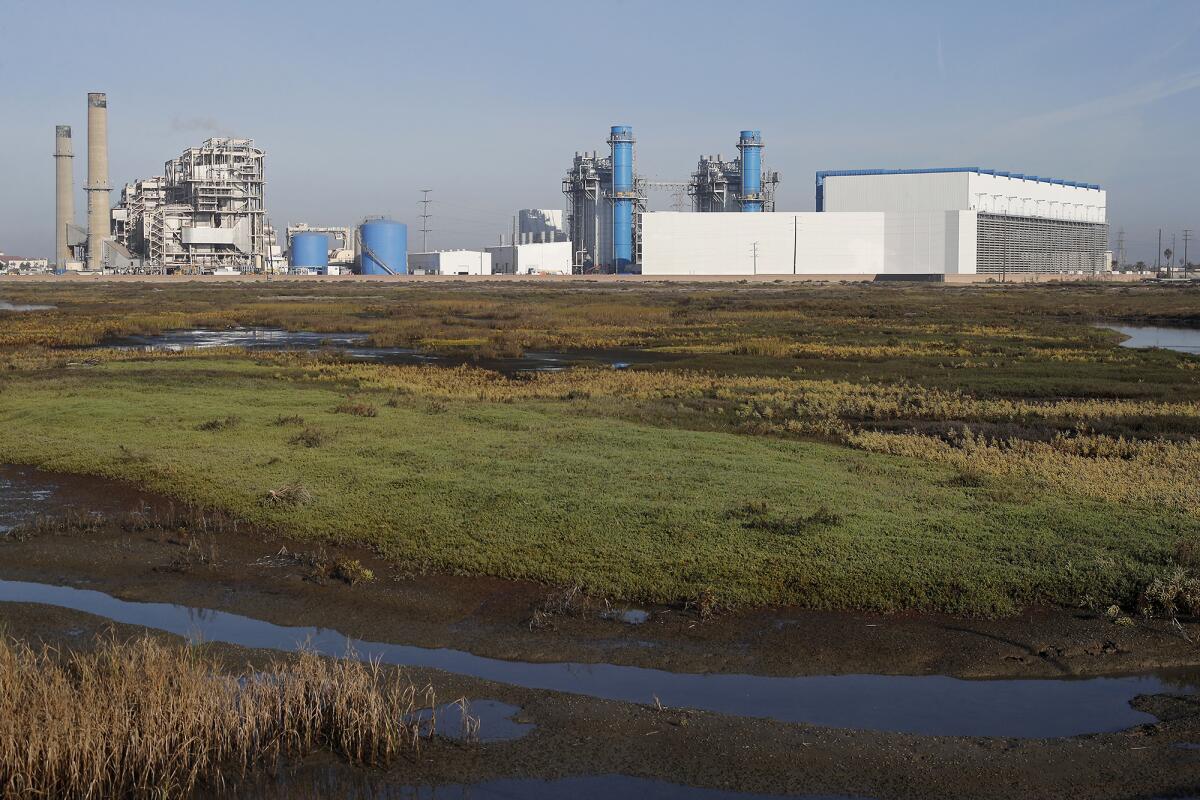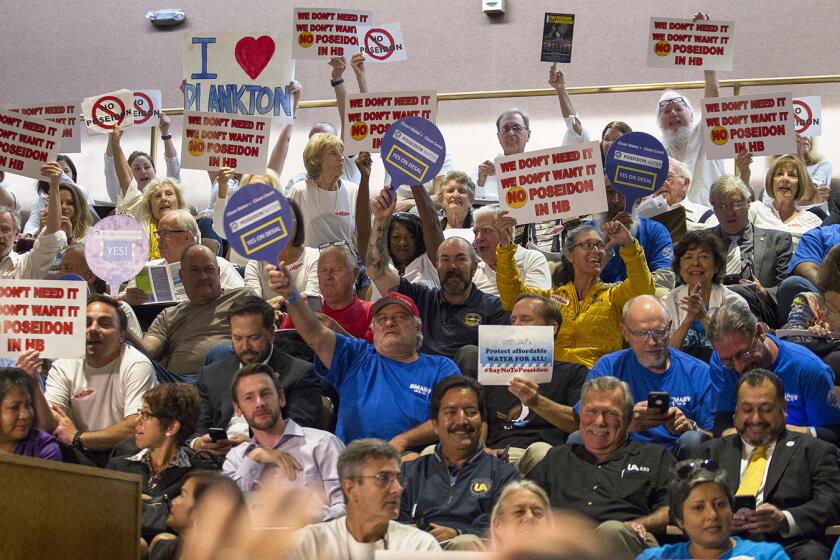Huntington Beach desalination plant appears headed for a key approval

- Share via
Poseidon Water’s long-delayed plans to build one of the West Coast’s biggest seawater desalination plants on the Huntington Beach coastline appear headed for a key approval.
A regional water board is proposing to grant Poseidon permits for a $1-billion desalting facility that would annually produce enough drinking water to supply 100,000 Orange County households.
The board will not vote on the project until March and Poseidon still needs approval from the California Coastal Commission.
But the water board’s tentative permit is a major boost for a project that has been mired in delays and controversy since it was first proposed two decades ago.
“We are one step closer to providing Orange County with a 100% drought-proof, climate-resilient new water supply project,” Poseidon communications director Jessica Jones said in an email.
In a tentative permit that Poseidon opponents quickly criticized, the Santa Ana Regional Water Quality Control Board would allow the company to use existing ocean pipes to draw seawater and discharge the brine left over from the desalting process.
“The regional board gave Poseidon everything they asked for,” said Sean Bothwell, executive director of California Coastkeeper Alliance, one of several environmental groups that have long fought the project.
“If the permit stays as it is now, we’ll certainly be appealing this,” he added.
A proposed Huntington Beach seawater desalination plant passed a major regulatory hurdle Thursday when a marathon session at City Hall concluded with an endorsement from the California State Lands Commission.
Meanwhile, the desalination plant was invited to apply for $585 million in credit assistance under the U.S. Environmental Protection Agency’s Water Infrastructure Finance and Innovation Act program, which supplies long-term, low-cost supplemental loans for water infrastructure projects that are deemed “regionally and nationally significant,” according to the EPA website.
On Oct. 22, Poseidon was identified as one of 38 projects across 18 states invited to take advantage of a total of $6.3 billion, according to the EPA.
In a commentary written this month to the Daily Pilot, Anaheim City Councilman Jordan Brandman, a member of the Orange County Water District board of directors, said the water district sponsored Poseidon’s WIFIA application and that Poseidon would be receiving the credit assistance. However, the EPA was unable to confirm this week any progress beyond the invitation to apply.
Poseidon has a nonbinding agreement with the Orange County Water District to purchase the Huntington Beach supplies, but no final contract.
Despite the project’s steps forward, environmental advocates and others continue to raise concerns about the plant’s potential effects ahead of a Dec. 6 Santa Ana Regional Water Quality Control Board meeting that will include a workshop on the Poseidon permit where the public can comment. The meeting will begin at 9 a.m. at Huntington Beach City Hall, 200 Main St.
Ahead of the hearing, Costa Mesa-based Orange County Coastkeeper will hold a “virtual town hall” on its Facebook page at 7 p.m. Dec. 4 in which the environmental group will tell watchers and participants what to expect at the Dec. 6 meeting and how they can participate.
As the first major coastal desalination plant to seek approval under new state ocean protection rules, the fate of Poseidon’s Huntington Beach facility could set the course for future projects, including a water district’s proposal to build a seawater desalter off the Los Angeles coast in El Segundo.
The proposed ocean intake off Huntington Beach has been a major point of contention. It would, with some modification, continue a form of seawater withdrawal that the state ordered coastal power plants to phase out because it killed minute marine life.
Poseidon plans to build the desalter next to AES’ Huntington Beach Generating Station, and after the power plant stops using seawater for cooling, connect the new desalter to the old AES intake pipe that reaches roughly a quarter-mile into the Pacific Ocean and is big enough for a tractor-trailer to drive through.
Coastal Commission staff has pushed Poseidon to abandon the open ocean intake, which sucks up plankton, fish larvae and other organisms that are a vital part of the sea’s food chain.
Instead, commission staff has urged the company to construct an offshore subsurface intake called an infiltration gallery — a grid of perforated collection pipes beneath the ocean floor that draws seawater without pulling in marine organisms.
But it is the regional water board, not the Coastal Commission, that issues permits for Poseidon’s ocean intake and discharge. Citing a provision in the new ocean rules, board staff concluded that subsurface intakes wouldn’t work for such a large-volume desalination operation.
Poseidon has agreed to install fine-mesh screens on the intake to reduce marine mortality. It also will attach diffusing equipment to the end of the outfall pipe to prevent the dense brine effluent — twice as salty as seawater — from falling to the ocean floor in a deadly mass.
“The tentative order is scientifically sound … and correctly finds the proposed facility complies with the California Ocean Plan by using the best available site, design, technology and mitigation measures feasible,” Jones said.
Ocean advocates argued that the water board proposal ignores the core of the new state desalination safeguards.
“They’re not requiring Poseidon to meet any of the top-tier standards in the desalination [rules], which are the critical standards,” said Susan Jordan, executive director of the California Coastal Protection Network.
Despite seawater desalination’s appeal as a drought-proof water supply in a semi-arid state, California has been slow to embrace the coastal plants, which are energy-intensive, produce expensive water and exact a toll on the ocean environment.
A recent study by another Orange County agency concluded that other, less expensive water sources could meet the area’s future demand.
Poseidon has spent more than $1.6 million on lobbying and political campaign contributions during the past two decades to overcome those reservations. In 2017, it hired former California Sen. Barbara Boxer to lobby the Coastal Commission.
The company, which is owned by an international infrastructure firm, built California’s first big seawater desalter on the Carlsbad coast in San Diego County.
That facility was recently sold to Aberdeen Standard Investments for an undisclosed sum. Poseidon will continue to operate the plant, which has a long-term contract to supply the San Diego County Water Authority.
Bettina Boxall writes for the Los Angeles Times. Julia Sclafani is a Daily Pilot staff writer.
Updates
3:37 p.m. Nov. 27, 2019: This article was originally published at 1:04 p.m. and has been updated with additional information.
All the latest on Orange County from Orange County.
Get our free TimesOC newsletter.
You may occasionally receive promotional content from the Daily Pilot.






